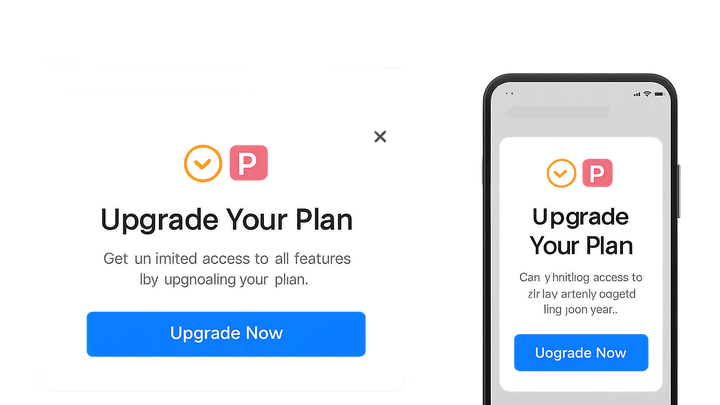Published on 2025-06-29T20:34:15Z
What is an Upgrade Prompt? Examples for Upgrade Prompt.
An Upgrade Prompt is a targeted interface element—such as a modal, banner, or inline overlay—designed to encourage users to upgrade their experience, subscribe, or provide their contact details.
In the context of CRO (Conversion Rate Optimization), UX (User Experience), and SEO (Search Engine Optimization), upgrade prompts serve as strategic micro-conversions that guide users toward valuable actions.
These prompts can appear as:
- Exit-intent popups
- Scroll-triggered banners
- Inline call-to-action elements
By delivering compelling messaging and timing it effectively, upgrade prompts help capture leads, enhance user engagement, and improve SEO metrics by reducing bounce rates.
Example HTML implementation:
<div class='upgrade-prompt'>
<h2>Upgrade for 10% Off!</h2>
<p>Subscribe now to access exclusive features.</p>
<button>Upgrade Now</button>
</div>
Tools like Prevue.me can analyze and optimize these prompts, offering actionable critiques to maximize lead generation, conversion rates, and accessibility across devices.
Upgrade prompt
A targeted interface element urging users to upgrade, subscribe, or convert, optimized for CRO, UX, SEO, and lead generation.
Definition and Purpose
An upgrade prompt is a strategic interface element that encourages users to take a higher-value action—such as subscribing or upgrading. When implemented thoughtfully, it balances user experience with conversion goals by delivering offers at the right moment.
-
What is an upgrade prompt?
A concise definition: an element like a modal, banner, or inline overlay asking users to upgrade or subscribe.
-
Goals of an upgrade prompt
The primary objectives and benefits across CRO, UX, and SEO.
- Boost conversion rates:
Encourages users to complete desired actions, improving website ROI.
- Enhance user journey:
Provides clear next steps, reducing confusion and frustration.
- Improve lead quality:
Captures contact information from genuinely interested visitors.
- Boost conversion rates:
Key Components
Breaks down the essential elements that make an upgrade prompt effective and user-friendly.
-
Compelling copy
Crafting concise, persuasive text to drive action.
- Headline:
A clear, benefit-focused statement to grab attention.
- Body text:
Supporting details that reinforce value propositions.
- Call-to-action button:
A strong, action-oriented label that prompts clicks.
- Headline:
-
Engaging design
Visual factors that improve clarity and appeal.
- Layout:
A clean structure to focus user attention.
- Color contrast:
Accessible palettes to ensure readability.
- Imagery:
Supporting visuals or icons to reinforce messaging.
- Layout:
-
Trigger mechanisms
The timing and conditions that activate prompts without disrupting UX.
- Exit-intent:
Displays when the cursor moves toward the browser’s close button.
- Scroll-triggered:
Appears after the user scrolls a set percentage down the page.
- Time delay:
Shows after a user has spent a certain time on the page.
- Exit-intent:
Examples with Prevue.me
Illustrates how prevue.me can generate and optimize upgrade prompts for different scenarios.
-
Post-critique upsell
After delivering feedback, prevue.me can trigger a prompt offering a detailed audit subscription.
-
Exit-intent discount prompt
prevue.me recommends showing a 10% discount when a user signals intent to leave.
-
Scroll-triggered demo invitation
Upon scrolling 50%, users see an invitation to schedule a live demo via a pop-up.
Best Practices
Strategic guidelines to ensure upgrade prompts are effective, user-friendly, and compliant.
-
Implement a/b testing
Experiment with variations in copy, design, and triggers to identify top performers.
- Test copy variations:
Compare headlines, body text, and CTA labels.
- Design layouts:
Try different modal sizes and positions.
- Trigger timing:
Evaluate exit-intent versus timed pop-ups.
- Test copy variations:
-
Optimize for mobile
Ensure prompts are responsive and unobtrusive on smaller screens.
- Responsive layout:
Adjust modal dimensions for mobile viewports.
- Touch-friendly buttons:
Use adequately sized tappable elements.
- Responsive layout:
-
Ensure accessibility
Comply with WCAG standards to make prompts usable for all.
- Aria labels:
Provide descriptive labels for screen readers.
- Keyboard navigation:
Allow prompts to be opened and closed via keyboard.
- Color contrast:
Maintain a minimum contrast ratio of 4.5:1.
- Aria labels:
-
Maintain seo-friendly markup
Use semantic HTML and avoid blocking critical content.
Measuring and Optimizing
Approaches to track performance and continuously refine upgrade prompts.
-
Track key metrics
Monitor conversion rate, click-through rate, and bounce rate to gauge effectiveness.
- Conversion rate:
Percentage of prompt views resulting in the desired action.
- Click-through rate:
Ratio of clicks on the prompt versus impressions.
- Bounce rate impact:
Changes in overall site bounce rate after implementing prompts.
- Conversion rate:
-
Analyze user behavior
Use analytics and heatmap tools to understand how users interact with prompts.
- Heatmaps:
Visualize click and scroll patterns.
- Session recordings:
Observe individual user sessions for context.
- Funnel analysis:
Identify drop-off points in the upgrade flow.
- Heatmaps:
-
Iterate and improve
Apply insights to refine copy, design, and triggers in regular cycles.
